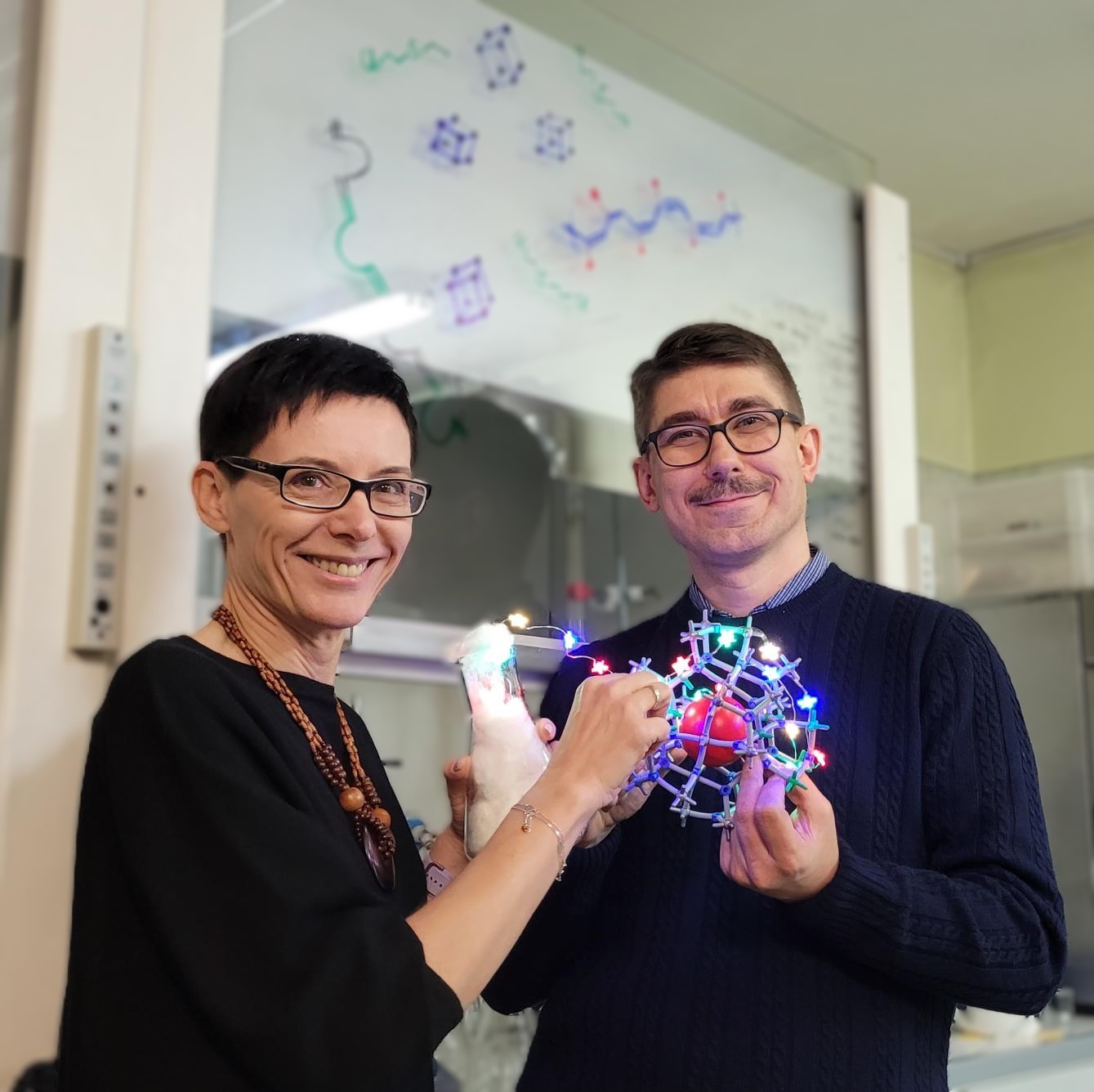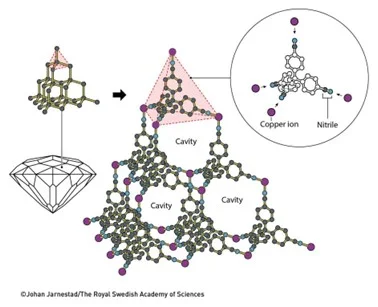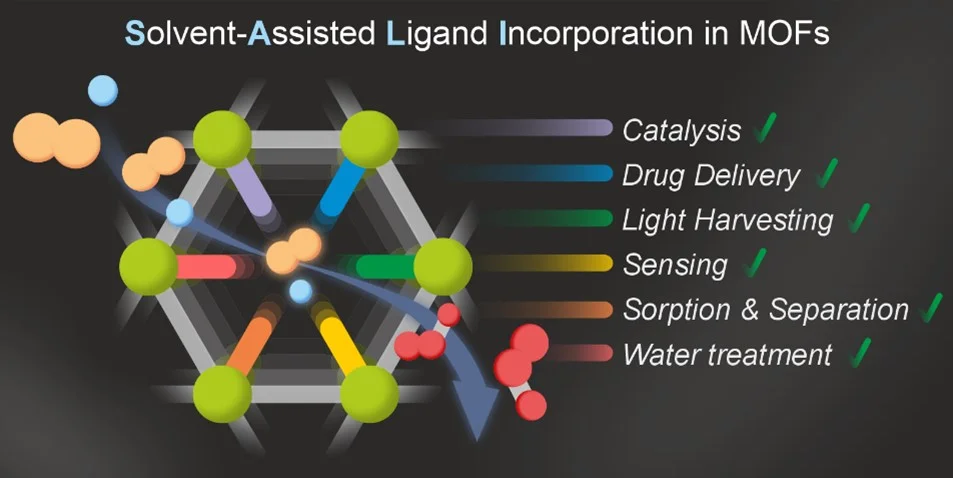
Professor Wojciech Bury – insights about the Nobel Prize in Chemistry 2025
What are MOFs and what is so fascinating about them that three researchers were awarded by the Nobel Committee for their contribution towards research development on these materials with this year’s Nobel Prize in Chemistry?
Nobel Prize in Chemistry 2025 was awarded to three scientists – Professor Susumu Kitagawa from Japan, Professor Richard Robson from Australia, and Professor Omar M. Yaghi from the USA – “for the development of metal-organic frameworks”. The topic of MOFs (metal-organic frameworks) is made familiar by Professor Wojciech Bury from the Faculty of Chemistry of the University of Wrocław.
What are the mysterious MOFs?
Metal-organic frameworks are a remarkably curious and special class of porous materials that have fascinated scientists worldwide for over two decades. These materials contain free spaces (pores) in their construction, which are filled with so-called guest molecules. Such construction brings to mind a plain image of a sponge, while the process of guest molecules adsorption in pores might evoke an image of soaking a sponge in water during a relaxing bath or a less relaxing image of washing dishes. Of course, it should be noted that it is nature itself that has been supplying us with a variety of porous materials for ages, including pumice, charcoal, and zeolite (commonly called “boiling stones”).
Each of the three awarded scientists has made pioneering discoveries in this field. Professor Richard Robson presented the first example of a crystallized coordination polymer containing “empty spaces” in its crystal [J. Am. Chem. Soc. 1989, 111, 5962]. Of course, nature “hates” emptiness, so these “holes” were filled with solvent molecules. This discovery was an inspiration for future researchers. Back then, nobody expected that chemists would soon have tens, or even hundreds of thousands, of such materials at their disposal, which is the situation we currently find ourselves in.
A diamond structure, in which every carbon atom is connected with four other carbon atoms in the shape of a pyramid, served as the inspiration for R. Roberts. Instead of carbon atoms, Robson used copper I ions and four-armed molecules, with each arm having a nitrile group at its end. This resulted in the creation of a crystal with a structure analogous to that of a diamond, but containing pores.

On the other hand, Professor Omar M. Yaghi created a groundwork for a field of study during the 1990s, which today is called “reticular chemistry” [Nature, 1999, 402, 276]. Professor Yaghi suggested and showcased how to create porous coordination polymers, which he named MOF – metal-organic frameworks. It was Professor Yaghi who presented to the world that MOF networks can be treated as structures created from two types of building blocks (clusters and linkers), which together form a coordinated network containing free spaces (pores) of different shapes and sizes. Reticular chemistry, which has emerged from the well-known field of coordination chemistry, deals with the design of well-defined porous materials.
Professor Susumu Kitagawa of Kyoto University – the third awarded scientist – is an incredibly versatile researcher. In the 1990s he focused on researching fundamental aspects of porosity and durability of coordination polymers – nowadays colloquially called MOFs. Thanks to Professor Kitagawa’s studies and research, we have learned how guest molecules react with the host network, as well as which dynamic responses decide the stiffness and elasticity of MOFs.
What can these materials be used for?
What makes MOFs stand out from other materials is their sorption capacity, which is connected with the presence of pores in their structure. Thanks to this quality, MOF networks have a vast specific surface area, which can reach over 7000 m2/g. In other words, just 1 gram of this material may have the surface of a football field (7000 m2). This is why many of MOFs’ applications include using them in processes of sorption and separation of gases. Some of the most promising applications of MOFs include hydrogen storage (green energy), methane and carbon dioxide storage (greenhouse gases), and adsorption of water from the air (even in a desert). Aside from these applications, MOFs can also be used as nano-scale reactors while conducting chemical reactions. There are several compelling examples of MOF usage in catalysis. Each of these applications poses a significant challenge for chemists, physicists, and engineers alike, which is why scientists constantly work on perfecting well-researched materials so that their synthesis may be cheaper and fully replicable. In this aspect, there is still plenty of work ahead of us…
On this remarkable occasion, we would like to invite everyone interested to read our “guide” titled: “Metal-organic frameworks in a nutshell – theoretical and practical guide”, which we have prepared and published together with Zespół Chemii Retikularnej i Katalizy in Wiadomości Chemiczne:
Pander, M.; Skałecka, N.; Prus, J.; Stani, O.; Bury, W. Metal-organic frameworks in a nutshell – theoretical and practical guide. Wiadomości Chemiczne 2024, 78, 1697–1729. (https://ptchem.pl/storage/pages/December2024/Pander.pdf)
Furthermore, in September 2025 we published our review in “Chemical Communications”, which we dedicated to the Faculty of Chemistry of the University of Wrocław to commemorate 30 years since its inception:
Pander, M.; Stachura, E.; Kozieł-Szymańska, M.; Bury, W. When MOFs Met SALI: Solvent-Assisted Ligand Incorporation in Metal–Organic Frameworks for Catalysis and Beyond. Chem. Commun. 2025, 10.1039.D5CC04299B.

More about the research on MOFs by our chemists:
Chemistry and chemical pollution
The beauty of symmetry and love of chemistry
Translated by Michał Zajączkowski (student of English Studies at the University of Wrocław) as part of the translation practice.
Added by: E.K.
Date of publication: 09.10.2025



